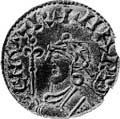The son and legitimate heir of King Cnut and Emma, widow of King Æthelred Unræd and daughter of Richard I, duke of the Normans, Harthacnut was proclaimed king of the Danes by his father at the Trondheim assembly in 1028. Harthacnut was in Denmark when Cnut died on 12 Nov 1035 and Harthacnut's older half-brother, Harold, claimed the throne. The nobles met at Oxford to decide on succession. A party of Earl Leofric, northern thanes, and the naval men in London prevailed over the supporters of Harthacnut led by his mother. Harold, who had apparently been recognized as king north of the Thames, was also made regent for Harthacnut's lands in the south. As Harthacnut delayed his departure for England, Harold was eventually recognized as king of all England (1037). After the death of Harold the English nobles sent for Harthacnut, who stayed at Bruges, Flanders. He landed in England on 17 Jun 1040 and, according to John of Worcester, was shortly afterwards crowned. Imposing an excessive tax on English population caused popular resentment. In 1041 Harthacnut had to send an army to ravage Worcestershire for killing tax collectors. As a result of these actions, Harthacnut became extremely unpopular. Execution of some of the nobles further aggravated the situation. Harthacnut suffered a seizure and collapsed while over-indulging himself at a feast. He died on 8 Jun 1042, while attending a wedding, and was condemned by the authors of the Anglo-Saxon Chronicle as "he never did anything worthy of a king". Biography sources: [2][3][4][5] |

